Alternative Dispute Resolution Systems: A Legal Perspective
VerifiedAdded on 2020/07/23
|15
|4484
|63
AI Summary
This assignment delves into the English legal system, focusing on its structure and various laws that govern it. It also examines alternative dispute resolution (ADR) systems, including their benefits, challenges, and implementation in different contexts. The assignment is supported by references from academic journals and books, providing a comprehensive understanding of the topic.
Contribute Materials
Your contribution can guide someone’s learning journey. Share your
documents today.
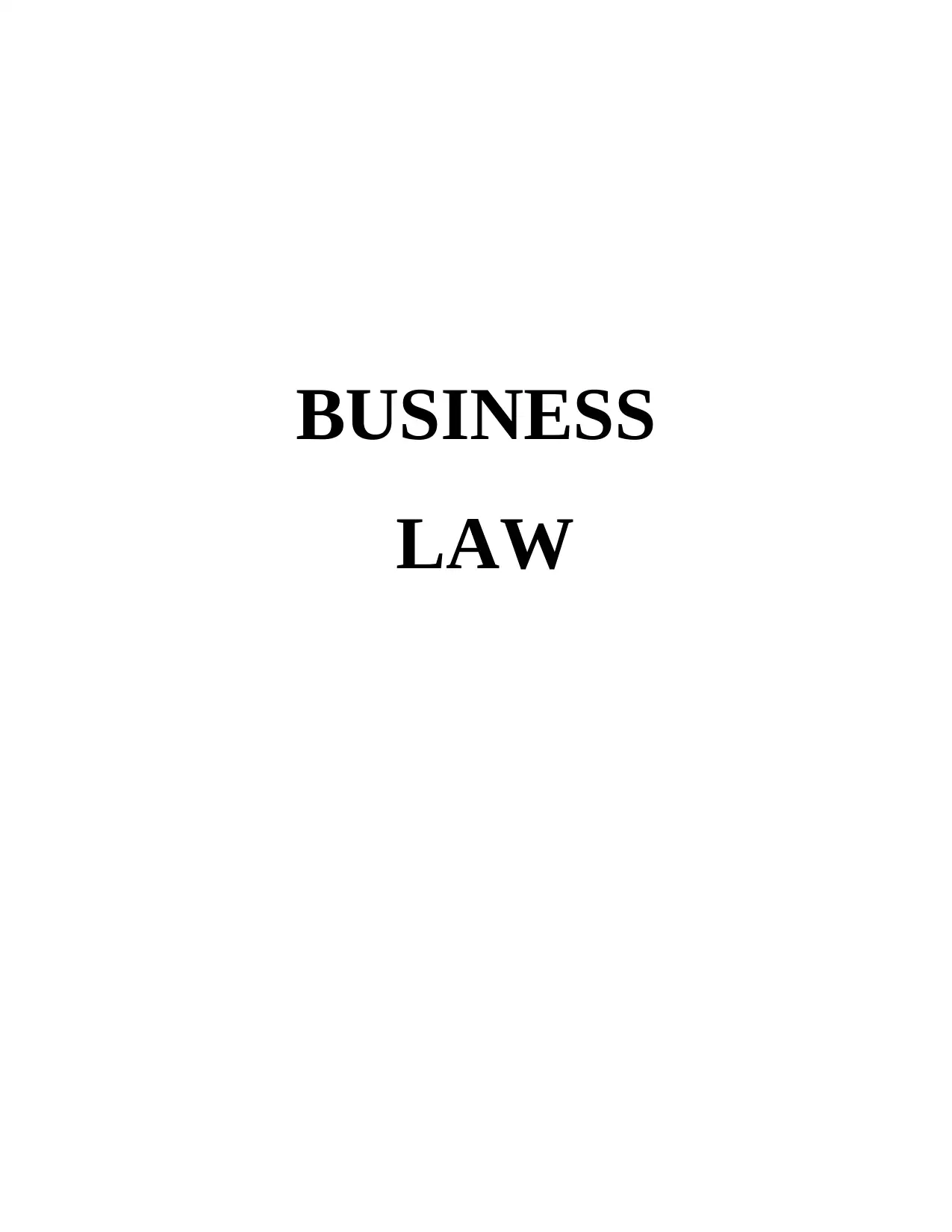
BUSINESS
LAW
LAW
Secure Best Marks with AI Grader
Need help grading? Try our AI Grader for instant feedback on your assignments.
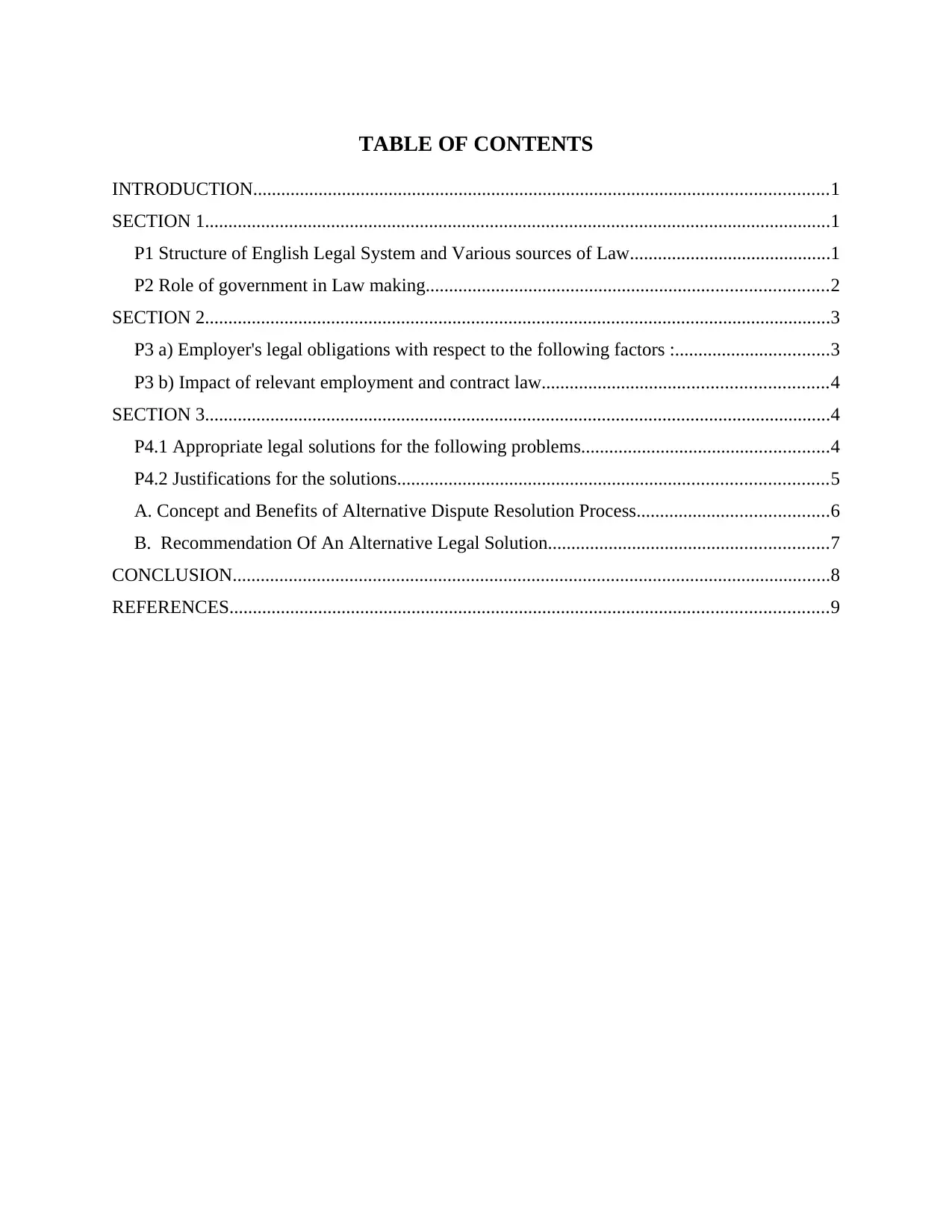
TABLE OF CONTENTS
INTRODUCTION...........................................................................................................................1
SECTION 1......................................................................................................................................1
P1 Structure of English Legal System and Various sources of Law...........................................1
P2 Role of government in Law making......................................................................................2
SECTION 2......................................................................................................................................3
P3 a) Employer's legal obligations with respect to the following factors :.................................3
P3 b) Impact of relevant employment and contract law.............................................................4
SECTION 3......................................................................................................................................4
P4.1 Appropriate legal solutions for the following problems.....................................................4
P4.2 Justifications for the solutions............................................................................................5
A. Concept and Benefits of Alternative Dispute Resolution Process.........................................6
B. Recommendation Of An Alternative Legal Solution............................................................7
CONCLUSION................................................................................................................................8
REFERENCES................................................................................................................................9
INTRODUCTION...........................................................................................................................1
SECTION 1......................................................................................................................................1
P1 Structure of English Legal System and Various sources of Law...........................................1
P2 Role of government in Law making......................................................................................2
SECTION 2......................................................................................................................................3
P3 a) Employer's legal obligations with respect to the following factors :.................................3
P3 b) Impact of relevant employment and contract law.............................................................4
SECTION 3......................................................................................................................................4
P4.1 Appropriate legal solutions for the following problems.....................................................4
P4.2 Justifications for the solutions............................................................................................5
A. Concept and Benefits of Alternative Dispute Resolution Process.........................................6
B. Recommendation Of An Alternative Legal Solution............................................................7
CONCLUSION................................................................................................................................8
REFERENCES................................................................................................................................9
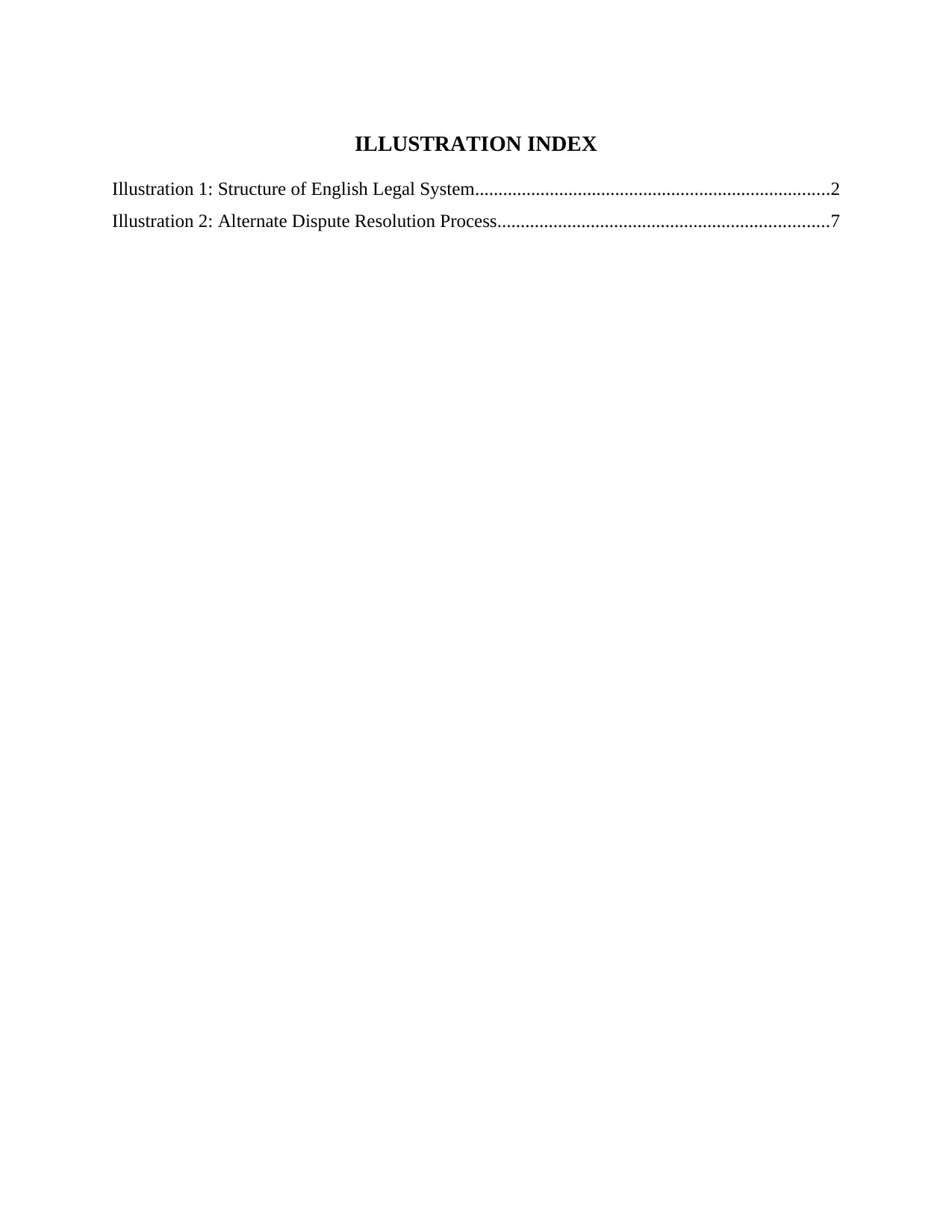
ILLUSTRATION INDEX
Illustration 1: Structure of English Legal System............................................................................2
Illustration 2: Alternate Dispute Resolution Process.......................................................................7
Illustration 1: Structure of English Legal System............................................................................2
Illustration 2: Alternate Dispute Resolution Process.......................................................................7
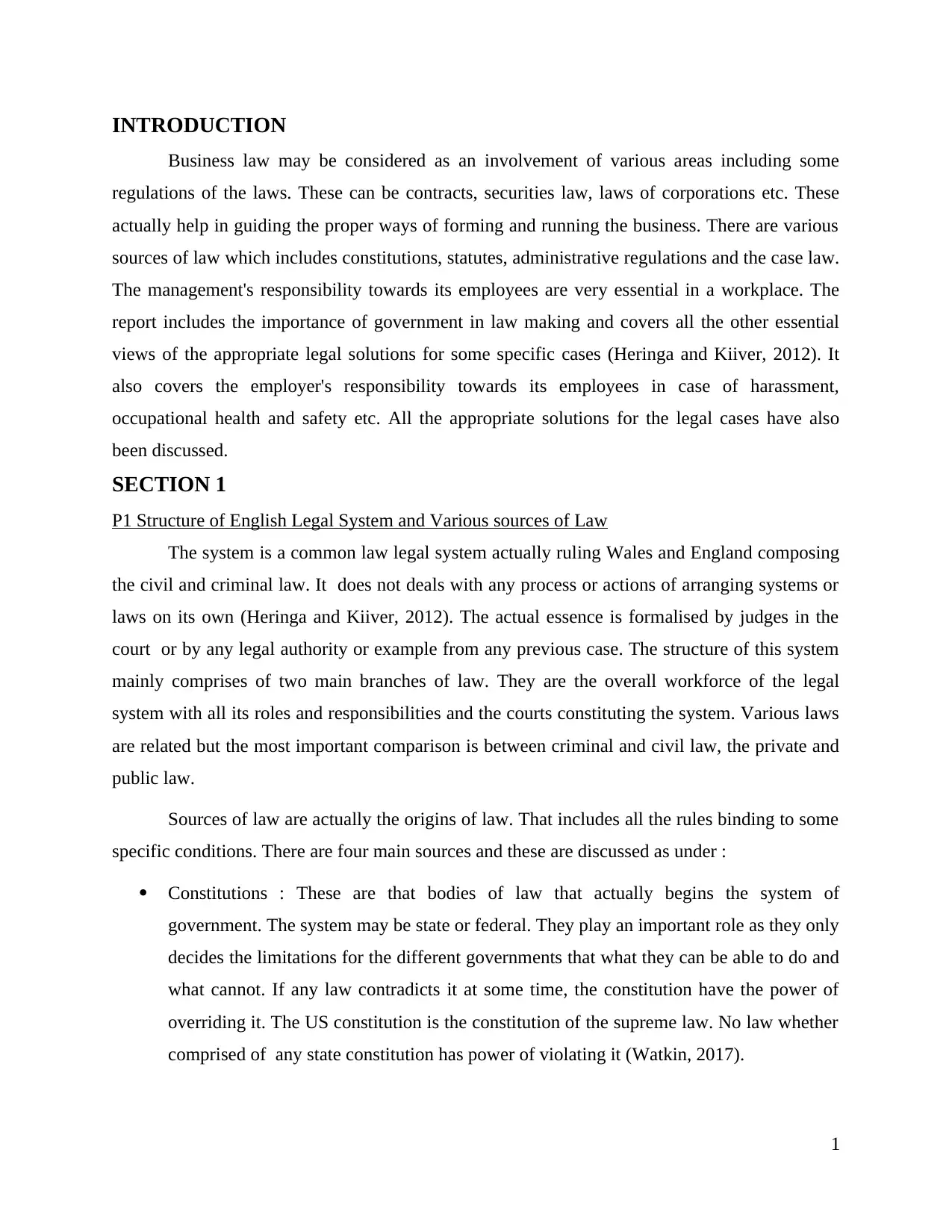
INTRODUCTION
Business law may be considered as an involvement of various areas including some
regulations of the laws. These can be contracts, securities law, laws of corporations etc. These
actually help in guiding the proper ways of forming and running the business. There are various
sources of law which includes constitutions, statutes, administrative regulations and the case law.
The management's responsibility towards its employees are very essential in a workplace. The
report includes the importance of government in law making and covers all the other essential
views of the appropriate legal solutions for some specific cases (Heringa and Kiiver, 2012). It
also covers the employer's responsibility towards its employees in case of harassment,
occupational health and safety etc. All the appropriate solutions for the legal cases have also
been discussed.
SECTION 1
P1 Structure of English Legal System and Various sources of Law
The system is a common law legal system actually ruling Wales and England composing
the civil and criminal law. It does not deals with any process or actions of arranging systems or
laws on its own (Heringa and Kiiver, 2012). The actual essence is formalised by judges in the
court or by any legal authority or example from any previous case. The structure of this system
mainly comprises of two main branches of law. They are the overall workforce of the legal
system with all its roles and responsibilities and the courts constituting the system. Various laws
are related but the most important comparison is between criminal and civil law, the private and
public law.
Sources of law are actually the origins of law. That includes all the rules binding to some
specific conditions. There are four main sources and these are discussed as under :
Constitutions : These are that bodies of law that actually begins the system of
government. The system may be state or federal. They play an important role as they only
decides the limitations for the different governments that what they can be able to do and
what cannot. If any law contradicts it at some time, the constitution have the power of
overriding it. The US constitution is the constitution of the supreme law. No law whether
comprised of any state constitution has power of violating it (Watkin, 2017).
1
Business law may be considered as an involvement of various areas including some
regulations of the laws. These can be contracts, securities law, laws of corporations etc. These
actually help in guiding the proper ways of forming and running the business. There are various
sources of law which includes constitutions, statutes, administrative regulations and the case law.
The management's responsibility towards its employees are very essential in a workplace. The
report includes the importance of government in law making and covers all the other essential
views of the appropriate legal solutions for some specific cases (Heringa and Kiiver, 2012). It
also covers the employer's responsibility towards its employees in case of harassment,
occupational health and safety etc. All the appropriate solutions for the legal cases have also
been discussed.
SECTION 1
P1 Structure of English Legal System and Various sources of Law
The system is a common law legal system actually ruling Wales and England composing
the civil and criminal law. It does not deals with any process or actions of arranging systems or
laws on its own (Heringa and Kiiver, 2012). The actual essence is formalised by judges in the
court or by any legal authority or example from any previous case. The structure of this system
mainly comprises of two main branches of law. They are the overall workforce of the legal
system with all its roles and responsibilities and the courts constituting the system. Various laws
are related but the most important comparison is between criminal and civil law, the private and
public law.
Sources of law are actually the origins of law. That includes all the rules binding to some
specific conditions. There are four main sources and these are discussed as under :
Constitutions : These are that bodies of law that actually begins the system of
government. The system may be state or federal. They play an important role as they only
decides the limitations for the different governments that what they can be able to do and
what cannot. If any law contradicts it at some time, the constitution have the power of
overriding it. The US constitution is the constitution of the supreme law. No law whether
comprised of any state constitution has power of violating it (Watkin, 2017).
1
Secure Best Marks with AI Grader
Need help grading? Try our AI Grader for instant feedback on your assignments.
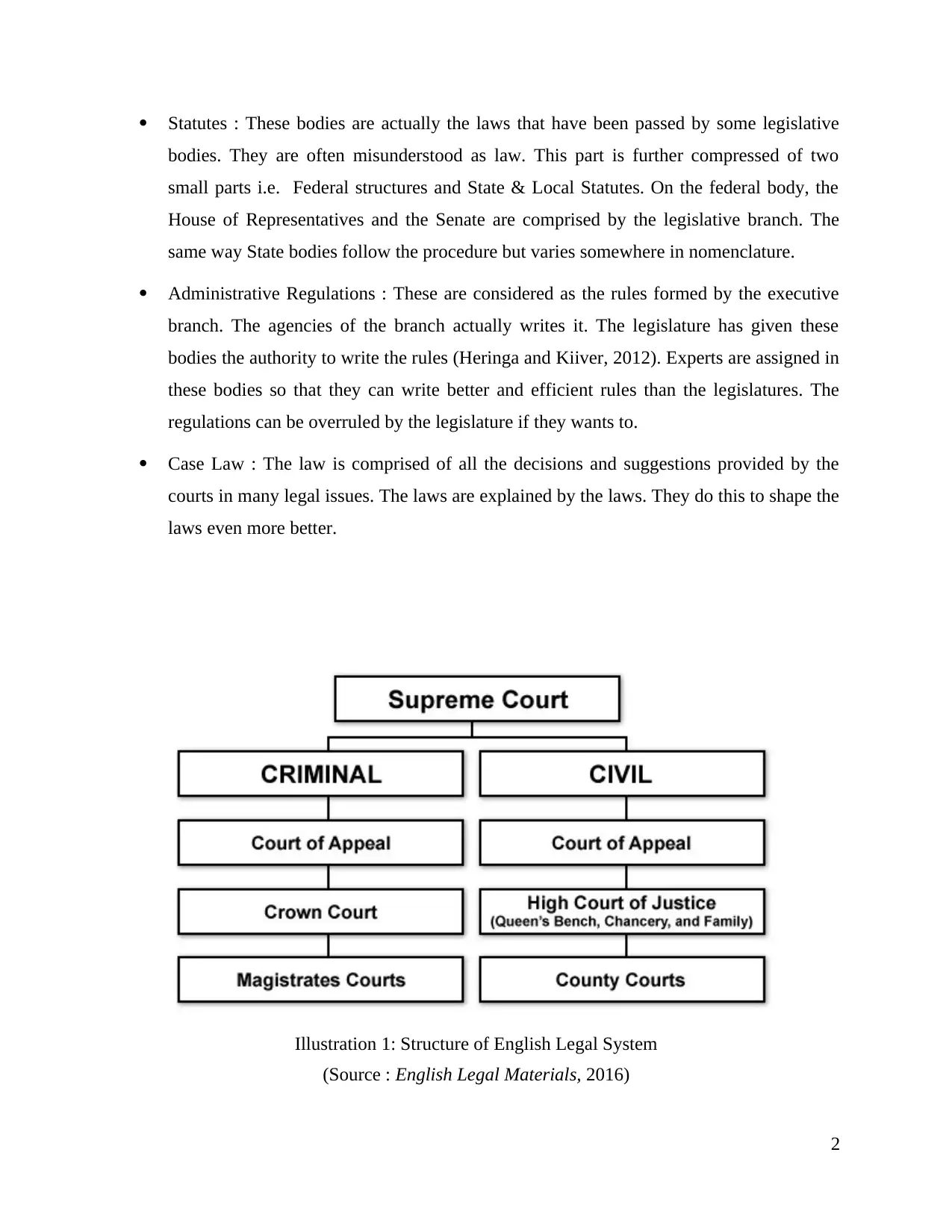
Statutes : These bodies are actually the laws that have been passed by some legislative
bodies. They are often misunderstood as law. This part is further compressed of two
small parts i.e. Federal structures and State & Local Statutes. On the federal body, the
House of Representatives and the Senate are comprised by the legislative branch. The
same way State bodies follow the procedure but varies somewhere in nomenclature.
Administrative Regulations : These are considered as the rules formed by the executive
branch. The agencies of the branch actually writes it. The legislature has given these
bodies the authority to write the rules (Heringa and Kiiver, 2012). Experts are assigned in
these bodies so that they can write better and efficient rules than the legislatures. The
regulations can be overruled by the legislature if they wants to.
Case Law : The law is comprised of all the decisions and suggestions provided by the
courts in many legal issues. The laws are explained by the laws. They do this to shape the
laws even more better.
2
Illustration 1: Structure of English Legal System
(Source : English Legal Materials, 2016)
bodies. They are often misunderstood as law. This part is further compressed of two
small parts i.e. Federal structures and State & Local Statutes. On the federal body, the
House of Representatives and the Senate are comprised by the legislative branch. The
same way State bodies follow the procedure but varies somewhere in nomenclature.
Administrative Regulations : These are considered as the rules formed by the executive
branch. The agencies of the branch actually writes it. The legislature has given these
bodies the authority to write the rules (Heringa and Kiiver, 2012). Experts are assigned in
these bodies so that they can write better and efficient rules than the legislatures. The
regulations can be overruled by the legislature if they wants to.
Case Law : The law is comprised of all the decisions and suggestions provided by the
courts in many legal issues. The laws are explained by the laws. They do this to shape the
laws even more better.
2
Illustration 1: Structure of English Legal System
(Source : English Legal Materials, 2016)
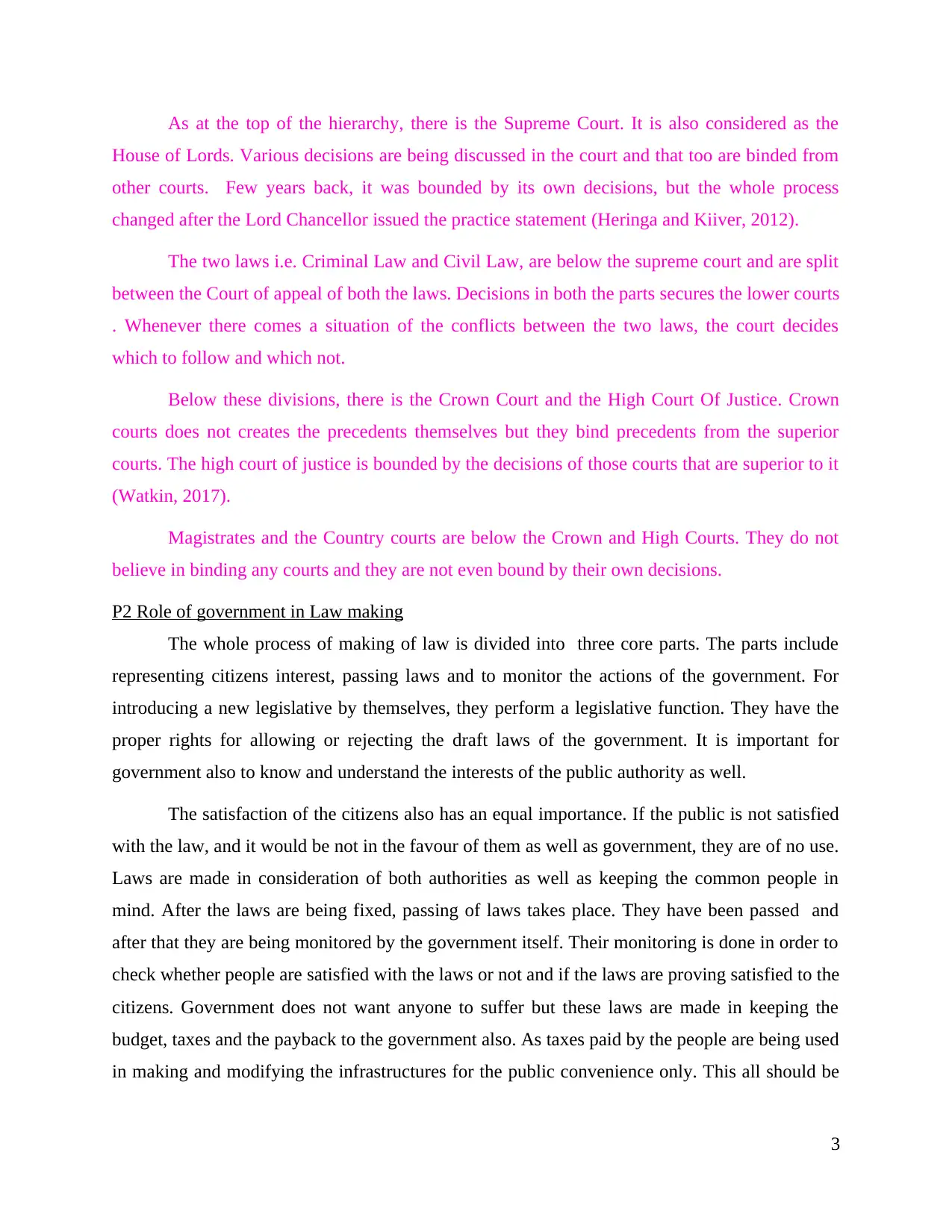
As at the top of the hierarchy, there is the Supreme Court. It is also considered as the
House of Lords. Various decisions are being discussed in the court and that too are binded from
other courts. Few years back, it was bounded by its own decisions, but the whole process
changed after the Lord Chancellor issued the practice statement (Heringa and Kiiver, 2012).
The two laws i.e. Criminal Law and Civil Law, are below the supreme court and are split
between the Court of appeal of both the laws. Decisions in both the parts secures the lower courts
. Whenever there comes a situation of the conflicts between the two laws, the court decides
which to follow and which not.
Below these divisions, there is the Crown Court and the High Court Of Justice. Crown
courts does not creates the precedents themselves but they bind precedents from the superior
courts. The high court of justice is bounded by the decisions of those courts that are superior to it
(Watkin, 2017).
Magistrates and the Country courts are below the Crown and High Courts. They do not
believe in binding any courts and they are not even bound by their own decisions.
P2 Role of government in Law making
The whole process of making of law is divided into three core parts. The parts include
representing citizens interest, passing laws and to monitor the actions of the government. For
introducing a new legislative by themselves, they perform a legislative function. They have the
proper rights for allowing or rejecting the draft laws of the government. It is important for
government also to know and understand the interests of the public authority as well.
The satisfaction of the citizens also has an equal importance. If the public is not satisfied
with the law, and it would be not in the favour of them as well as government, they are of no use.
Laws are made in consideration of both authorities as well as keeping the common people in
mind. After the laws are being fixed, passing of laws takes place. They have been passed and
after that they are being monitored by the government itself. Their monitoring is done in order to
check whether people are satisfied with the laws or not and if the laws are proving satisfied to the
citizens. Government does not want anyone to suffer but these laws are made in keeping the
budget, taxes and the payback to the government also. As taxes paid by the people are being used
in making and modifying the infrastructures for the public convenience only. This all should be
3
House of Lords. Various decisions are being discussed in the court and that too are binded from
other courts. Few years back, it was bounded by its own decisions, but the whole process
changed after the Lord Chancellor issued the practice statement (Heringa and Kiiver, 2012).
The two laws i.e. Criminal Law and Civil Law, are below the supreme court and are split
between the Court of appeal of both the laws. Decisions in both the parts secures the lower courts
. Whenever there comes a situation of the conflicts between the two laws, the court decides
which to follow and which not.
Below these divisions, there is the Crown Court and the High Court Of Justice. Crown
courts does not creates the precedents themselves but they bind precedents from the superior
courts. The high court of justice is bounded by the decisions of those courts that are superior to it
(Watkin, 2017).
Magistrates and the Country courts are below the Crown and High Courts. They do not
believe in binding any courts and they are not even bound by their own decisions.
P2 Role of government in Law making
The whole process of making of law is divided into three core parts. The parts include
representing citizens interest, passing laws and to monitor the actions of the government. For
introducing a new legislative by themselves, they perform a legislative function. They have the
proper rights for allowing or rejecting the draft laws of the government. It is important for
government also to know and understand the interests of the public authority as well.
The satisfaction of the citizens also has an equal importance. If the public is not satisfied
with the law, and it would be not in the favour of them as well as government, they are of no use.
Laws are made in consideration of both authorities as well as keeping the common people in
mind. After the laws are being fixed, passing of laws takes place. They have been passed and
after that they are being monitored by the government itself. Their monitoring is done in order to
check whether people are satisfied with the laws or not and if the laws are proving satisfied to the
citizens. Government does not want anyone to suffer but these laws are made in keeping the
budget, taxes and the payback to the government also. As taxes paid by the people are being used
in making and modifying the infrastructures for the public convenience only. This all should be
3
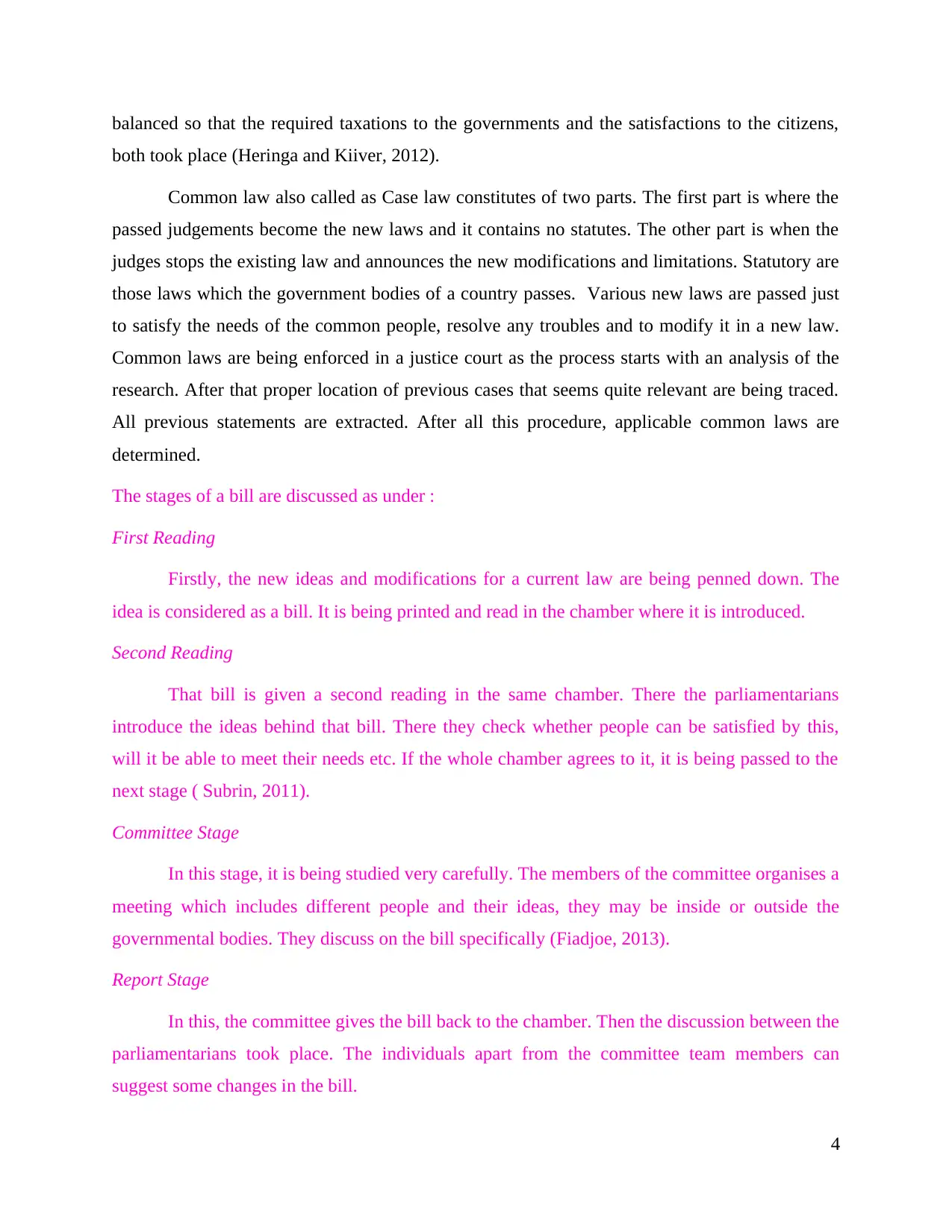
balanced so that the required taxations to the governments and the satisfactions to the citizens,
both took place (Heringa and Kiiver, 2012).
Common law also called as Case law constitutes of two parts. The first part is where the
passed judgements become the new laws and it contains no statutes. The other part is when the
judges stops the existing law and announces the new modifications and limitations. Statutory are
those laws which the government bodies of a country passes. Various new laws are passed just
to satisfy the needs of the common people, resolve any troubles and to modify it in a new law.
Common laws are being enforced in a justice court as the process starts with an analysis of the
research. After that proper location of previous cases that seems quite relevant are being traced.
All previous statements are extracted. After all this procedure, applicable common laws are
determined.
The stages of a bill are discussed as under :
First Reading
Firstly, the new ideas and modifications for a current law are being penned down. The
idea is considered as a bill. It is being printed and read in the chamber where it is introduced.
Second Reading
That bill is given a second reading in the same chamber. There the parliamentarians
introduce the ideas behind that bill. There they check whether people can be satisfied by this,
will it be able to meet their needs etc. If the whole chamber agrees to it, it is being passed to the
next stage ( Subrin, 2011).
Committee Stage
In this stage, it is being studied very carefully. The members of the committee organises a
meeting which includes different people and their ideas, they may be inside or outside the
governmental bodies. They discuss on the bill specifically (Fiadjoe, 2013).
Report Stage
In this, the committee gives the bill back to the chamber. Then the discussion between the
parliamentarians took place. The individuals apart from the committee team members can
suggest some changes in the bill.
4
both took place (Heringa and Kiiver, 2012).
Common law also called as Case law constitutes of two parts. The first part is where the
passed judgements become the new laws and it contains no statutes. The other part is when the
judges stops the existing law and announces the new modifications and limitations. Statutory are
those laws which the government bodies of a country passes. Various new laws are passed just
to satisfy the needs of the common people, resolve any troubles and to modify it in a new law.
Common laws are being enforced in a justice court as the process starts with an analysis of the
research. After that proper location of previous cases that seems quite relevant are being traced.
All previous statements are extracted. After all this procedure, applicable common laws are
determined.
The stages of a bill are discussed as under :
First Reading
Firstly, the new ideas and modifications for a current law are being penned down. The
idea is considered as a bill. It is being printed and read in the chamber where it is introduced.
Second Reading
That bill is given a second reading in the same chamber. There the parliamentarians
introduce the ideas behind that bill. There they check whether people can be satisfied by this,
will it be able to meet their needs etc. If the whole chamber agrees to it, it is being passed to the
next stage ( Subrin, 2011).
Committee Stage
In this stage, it is being studied very carefully. The members of the committee organises a
meeting which includes different people and their ideas, they may be inside or outside the
governmental bodies. They discuss on the bill specifically (Fiadjoe, 2013).
Report Stage
In this, the committee gives the bill back to the chamber. Then the discussion between the
parliamentarians took place. The individuals apart from the committee team members can
suggest some changes in the bill.
4
Paraphrase This Document
Need a fresh take? Get an instant paraphrase of this document with our AI Paraphraser
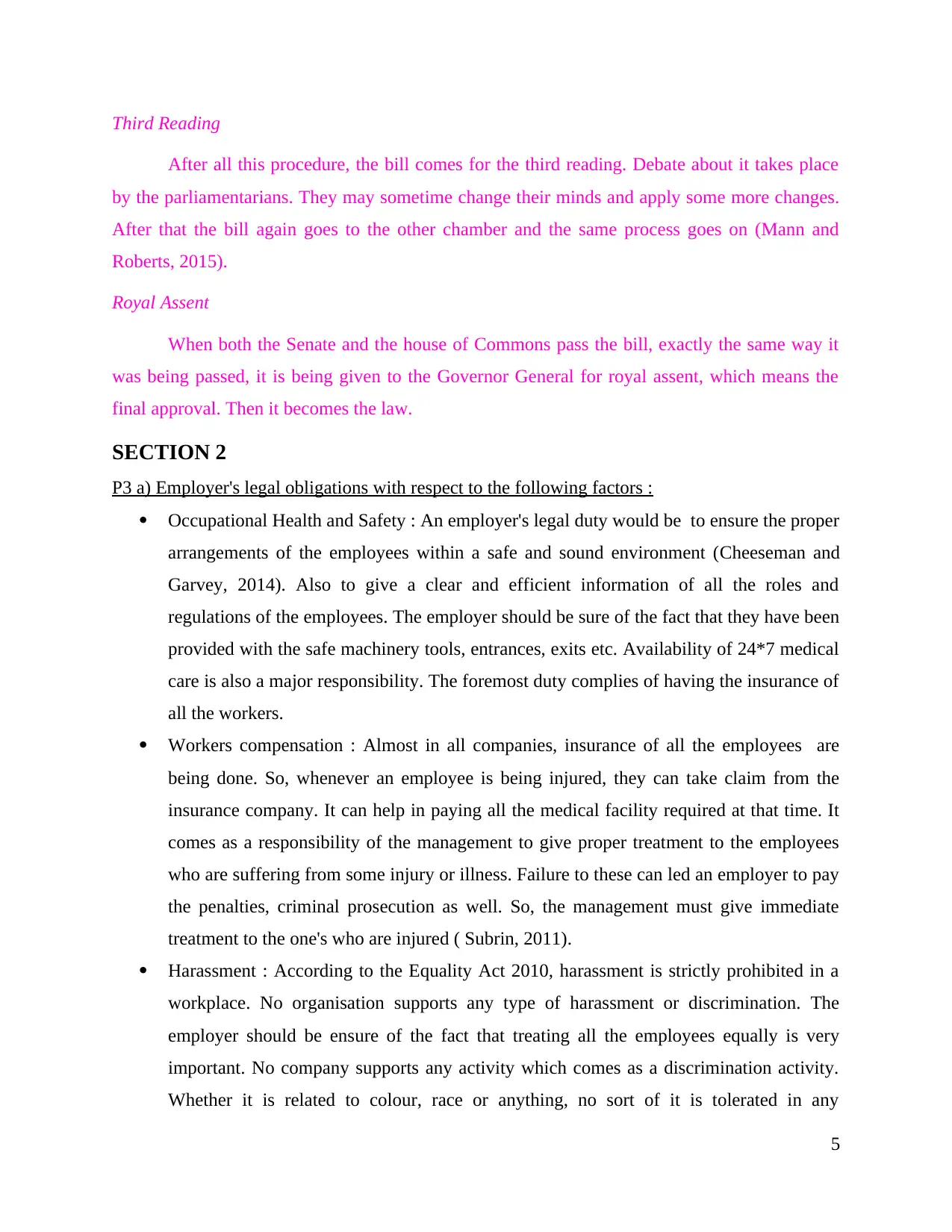
Third Reading
After all this procedure, the bill comes for the third reading. Debate about it takes place
by the parliamentarians. They may sometime change their minds and apply some more changes.
After that the bill again goes to the other chamber and the same process goes on (Mann and
Roberts, 2015).
Royal Assent
When both the Senate and the house of Commons pass the bill, exactly the same way it
was being passed, it is being given to the Governor General for royal assent, which means the
final approval. Then it becomes the law.
SECTION 2
P3 a) Employer's legal obligations with respect to the following factors :
Occupational Health and Safety : An employer's legal duty would be to ensure the proper
arrangements of the employees within a safe and sound environment (Cheeseman and
Garvey, 2014). Also to give a clear and efficient information of all the roles and
regulations of the employees. The employer should be sure of the fact that they have been
provided with the safe machinery tools, entrances, exits etc. Availability of 24*7 medical
care is also a major responsibility. The foremost duty complies of having the insurance of
all the workers.
Workers compensation : Almost in all companies, insurance of all the employees are
being done. So, whenever an employee is being injured, they can take claim from the
insurance company. It can help in paying all the medical facility required at that time. It
comes as a responsibility of the management to give proper treatment to the employees
who are suffering from some injury or illness. Failure to these can led an employer to pay
the penalties, criminal prosecution as well. So, the management must give immediate
treatment to the one's who are injured ( Subrin, 2011).
Harassment : According to the Equality Act 2010, harassment is strictly prohibited in a
workplace. No organisation supports any type of harassment or discrimination. The
employer should be ensure of the fact that treating all the employees equally is very
important. No company supports any activity which comes as a discrimination activity.
Whether it is related to colour, race or anything, no sort of it is tolerated in any
5
After all this procedure, the bill comes for the third reading. Debate about it takes place
by the parliamentarians. They may sometime change their minds and apply some more changes.
After that the bill again goes to the other chamber and the same process goes on (Mann and
Roberts, 2015).
Royal Assent
When both the Senate and the house of Commons pass the bill, exactly the same way it
was being passed, it is being given to the Governor General for royal assent, which means the
final approval. Then it becomes the law.
SECTION 2
P3 a) Employer's legal obligations with respect to the following factors :
Occupational Health and Safety : An employer's legal duty would be to ensure the proper
arrangements of the employees within a safe and sound environment (Cheeseman and
Garvey, 2014). Also to give a clear and efficient information of all the roles and
regulations of the employees. The employer should be sure of the fact that they have been
provided with the safe machinery tools, entrances, exits etc. Availability of 24*7 medical
care is also a major responsibility. The foremost duty complies of having the insurance of
all the workers.
Workers compensation : Almost in all companies, insurance of all the employees are
being done. So, whenever an employee is being injured, they can take claim from the
insurance company. It can help in paying all the medical facility required at that time. It
comes as a responsibility of the management to give proper treatment to the employees
who are suffering from some injury or illness. Failure to these can led an employer to pay
the penalties, criminal prosecution as well. So, the management must give immediate
treatment to the one's who are injured ( Subrin, 2011).
Harassment : According to the Equality Act 2010, harassment is strictly prohibited in a
workplace. No organisation supports any type of harassment or discrimination. The
employer should be ensure of the fact that treating all the employees equally is very
important. No company supports any activity which comes as a discrimination activity.
Whether it is related to colour, race or anything, no sort of it is tolerated in any
5
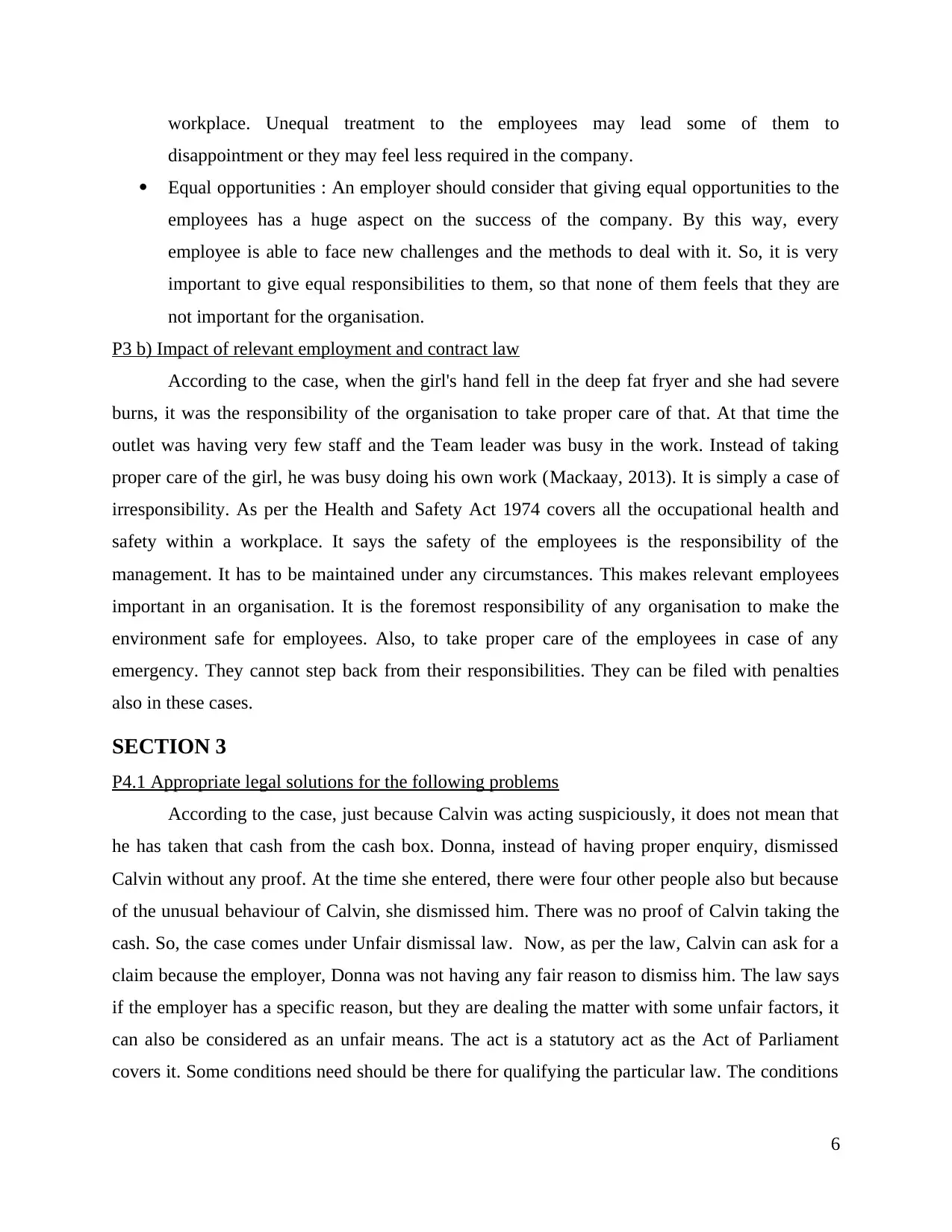
workplace. Unequal treatment to the employees may lead some of them to
disappointment or they may feel less required in the company.
Equal opportunities : An employer should consider that giving equal opportunities to the
employees has a huge aspect on the success of the company. By this way, every
employee is able to face new challenges and the methods to deal with it. So, it is very
important to give equal responsibilities to them, so that none of them feels that they are
not important for the organisation.
P3 b) Impact of relevant employment and contract law
According to the case, when the girl's hand fell in the deep fat fryer and she had severe
burns, it was the responsibility of the organisation to take proper care of that. At that time the
outlet was having very few staff and the Team leader was busy in the work. Instead of taking
proper care of the girl, he was busy doing his own work (Mackaay, 2013). It is simply a case of
irresponsibility. As per the Health and Safety Act 1974 covers all the occupational health and
safety within a workplace. It says the safety of the employees is the responsibility of the
management. It has to be maintained under any circumstances. This makes relevant employees
important in an organisation. It is the foremost responsibility of any organisation to make the
environment safe for employees. Also, to take proper care of the employees in case of any
emergency. They cannot step back from their responsibilities. They can be filed with penalties
also in these cases.
SECTION 3
P4.1 Appropriate legal solutions for the following problems
According to the case, just because Calvin was acting suspiciously, it does not mean that
he has taken that cash from the cash box. Donna, instead of having proper enquiry, dismissed
Calvin without any proof. At the time she entered, there were four other people also but because
of the unusual behaviour of Calvin, she dismissed him. There was no proof of Calvin taking the
cash. So, the case comes under Unfair dismissal law. Now, as per the law, Calvin can ask for a
claim because the employer, Donna was not having any fair reason to dismiss him. The law says
if the employer has a specific reason, but they are dealing the matter with some unfair factors, it
can also be considered as an unfair means. The act is a statutory act as the Act of Parliament
covers it. Some conditions need should be there for qualifying the particular law. The conditions
6
disappointment or they may feel less required in the company.
Equal opportunities : An employer should consider that giving equal opportunities to the
employees has a huge aspect on the success of the company. By this way, every
employee is able to face new challenges and the methods to deal with it. So, it is very
important to give equal responsibilities to them, so that none of them feels that they are
not important for the organisation.
P3 b) Impact of relevant employment and contract law
According to the case, when the girl's hand fell in the deep fat fryer and she had severe
burns, it was the responsibility of the organisation to take proper care of that. At that time the
outlet was having very few staff and the Team leader was busy in the work. Instead of taking
proper care of the girl, he was busy doing his own work (Mackaay, 2013). It is simply a case of
irresponsibility. As per the Health and Safety Act 1974 covers all the occupational health and
safety within a workplace. It says the safety of the employees is the responsibility of the
management. It has to be maintained under any circumstances. This makes relevant employees
important in an organisation. It is the foremost responsibility of any organisation to make the
environment safe for employees. Also, to take proper care of the employees in case of any
emergency. They cannot step back from their responsibilities. They can be filed with penalties
also in these cases.
SECTION 3
P4.1 Appropriate legal solutions for the following problems
According to the case, just because Calvin was acting suspiciously, it does not mean that
he has taken that cash from the cash box. Donna, instead of having proper enquiry, dismissed
Calvin without any proof. At the time she entered, there were four other people also but because
of the unusual behaviour of Calvin, she dismissed him. There was no proof of Calvin taking the
cash. So, the case comes under Unfair dismissal law. Now, as per the law, Calvin can ask for a
claim because the employer, Donna was not having any fair reason to dismiss him. The law says
if the employer has a specific reason, but they are dealing the matter with some unfair factors, it
can also be considered as an unfair means. The act is a statutory act as the Act of Parliament
covers it. Some conditions need should be there for qualifying the particular law. The conditions
6
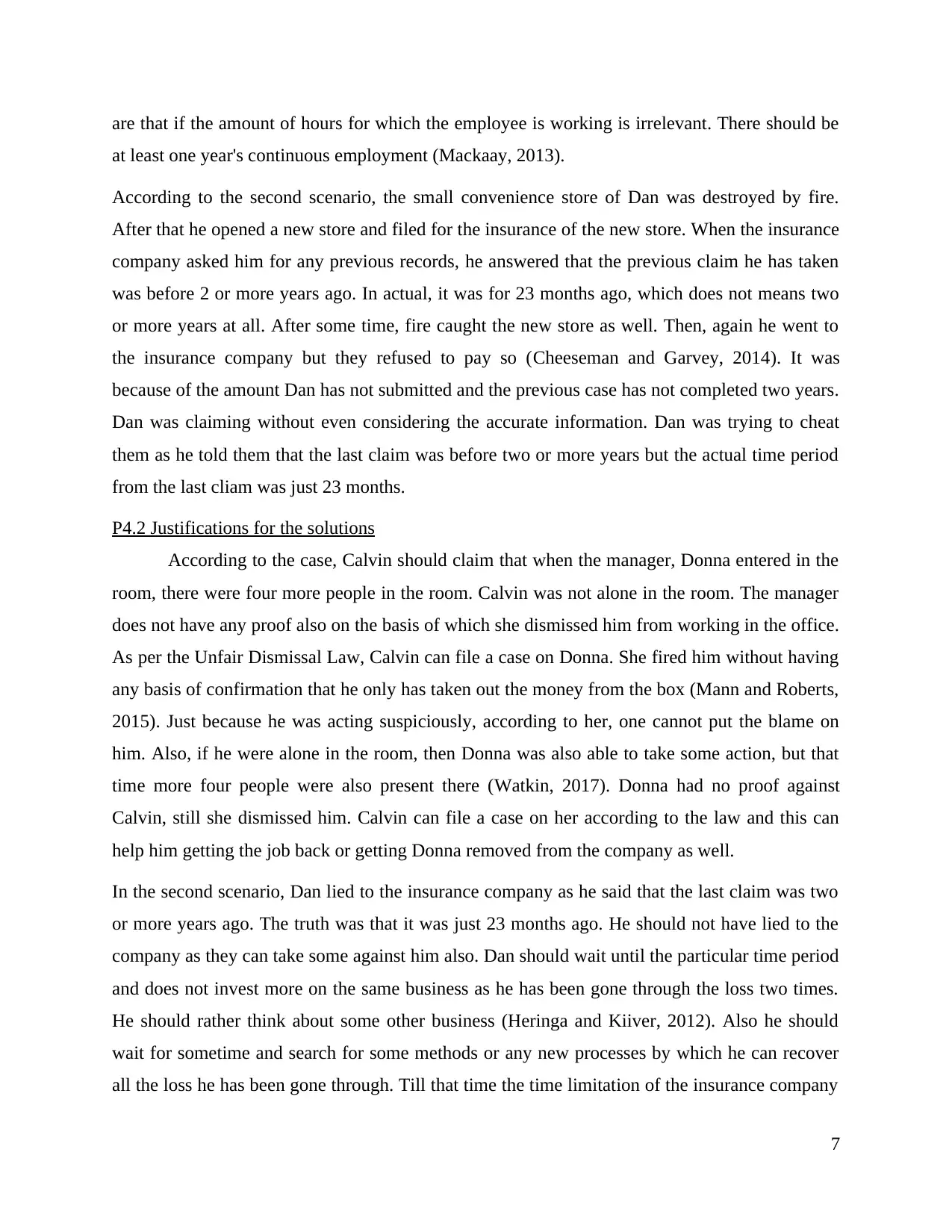
are that if the amount of hours for which the employee is working is irrelevant. There should be
at least one year's continuous employment (Mackaay, 2013).
According to the second scenario, the small convenience store of Dan was destroyed by fire.
After that he opened a new store and filed for the insurance of the new store. When the insurance
company asked him for any previous records, he answered that the previous claim he has taken
was before 2 or more years ago. In actual, it was for 23 months ago, which does not means two
or more years at all. After some time, fire caught the new store as well. Then, again he went to
the insurance company but they refused to pay so (Cheeseman and Garvey, 2014). It was
because of the amount Dan has not submitted and the previous case has not completed two years.
Dan was claiming without even considering the accurate information. Dan was trying to cheat
them as he told them that the last claim was before two or more years but the actual time period
from the last cliam was just 23 months.
P4.2 Justifications for the solutions
According to the case, Calvin should claim that when the manager, Donna entered in the
room, there were four more people in the room. Calvin was not alone in the room. The manager
does not have any proof also on the basis of which she dismissed him from working in the office.
As per the Unfair Dismissal Law, Calvin can file a case on Donna. She fired him without having
any basis of confirmation that he only has taken out the money from the box (Mann and Roberts,
2015). Just because he was acting suspiciously, according to her, one cannot put the blame on
him. Also, if he were alone in the room, then Donna was also able to take some action, but that
time more four people were also present there (Watkin, 2017). Donna had no proof against
Calvin, still she dismissed him. Calvin can file a case on her according to the law and this can
help him getting the job back or getting Donna removed from the company as well.
In the second scenario, Dan lied to the insurance company as he said that the last claim was two
or more years ago. The truth was that it was just 23 months ago. He should not have lied to the
company as they can take some against him also. Dan should wait until the particular time period
and does not invest more on the same business as he has been gone through the loss two times.
He should rather think about some other business (Heringa and Kiiver, 2012). Also he should
wait for sometime and search for some methods or any new processes by which he can recover
all the loss he has been gone through. Till that time the time limitation of the insurance company
7
at least one year's continuous employment (Mackaay, 2013).
According to the second scenario, the small convenience store of Dan was destroyed by fire.
After that he opened a new store and filed for the insurance of the new store. When the insurance
company asked him for any previous records, he answered that the previous claim he has taken
was before 2 or more years ago. In actual, it was for 23 months ago, which does not means two
or more years at all. After some time, fire caught the new store as well. Then, again he went to
the insurance company but they refused to pay so (Cheeseman and Garvey, 2014). It was
because of the amount Dan has not submitted and the previous case has not completed two years.
Dan was claiming without even considering the accurate information. Dan was trying to cheat
them as he told them that the last claim was before two or more years but the actual time period
from the last cliam was just 23 months.
P4.2 Justifications for the solutions
According to the case, Calvin should claim that when the manager, Donna entered in the
room, there were four more people in the room. Calvin was not alone in the room. The manager
does not have any proof also on the basis of which she dismissed him from working in the office.
As per the Unfair Dismissal Law, Calvin can file a case on Donna. She fired him without having
any basis of confirmation that he only has taken out the money from the box (Mann and Roberts,
2015). Just because he was acting suspiciously, according to her, one cannot put the blame on
him. Also, if he were alone in the room, then Donna was also able to take some action, but that
time more four people were also present there (Watkin, 2017). Donna had no proof against
Calvin, still she dismissed him. Calvin can file a case on her according to the law and this can
help him getting the job back or getting Donna removed from the company as well.
In the second scenario, Dan lied to the insurance company as he said that the last claim was two
or more years ago. The truth was that it was just 23 months ago. He should not have lied to the
company as they can take some against him also. Dan should wait until the particular time period
and does not invest more on the same business as he has been gone through the loss two times.
He should rather think about some other business (Heringa and Kiiver, 2012). Also he should
wait for sometime and search for some methods or any new processes by which he can recover
all the loss he has been gone through. Till that time the time limitation of the insurance company
7
Secure Best Marks with AI Grader
Need help grading? Try our AI Grader for instant feedback on your assignments.
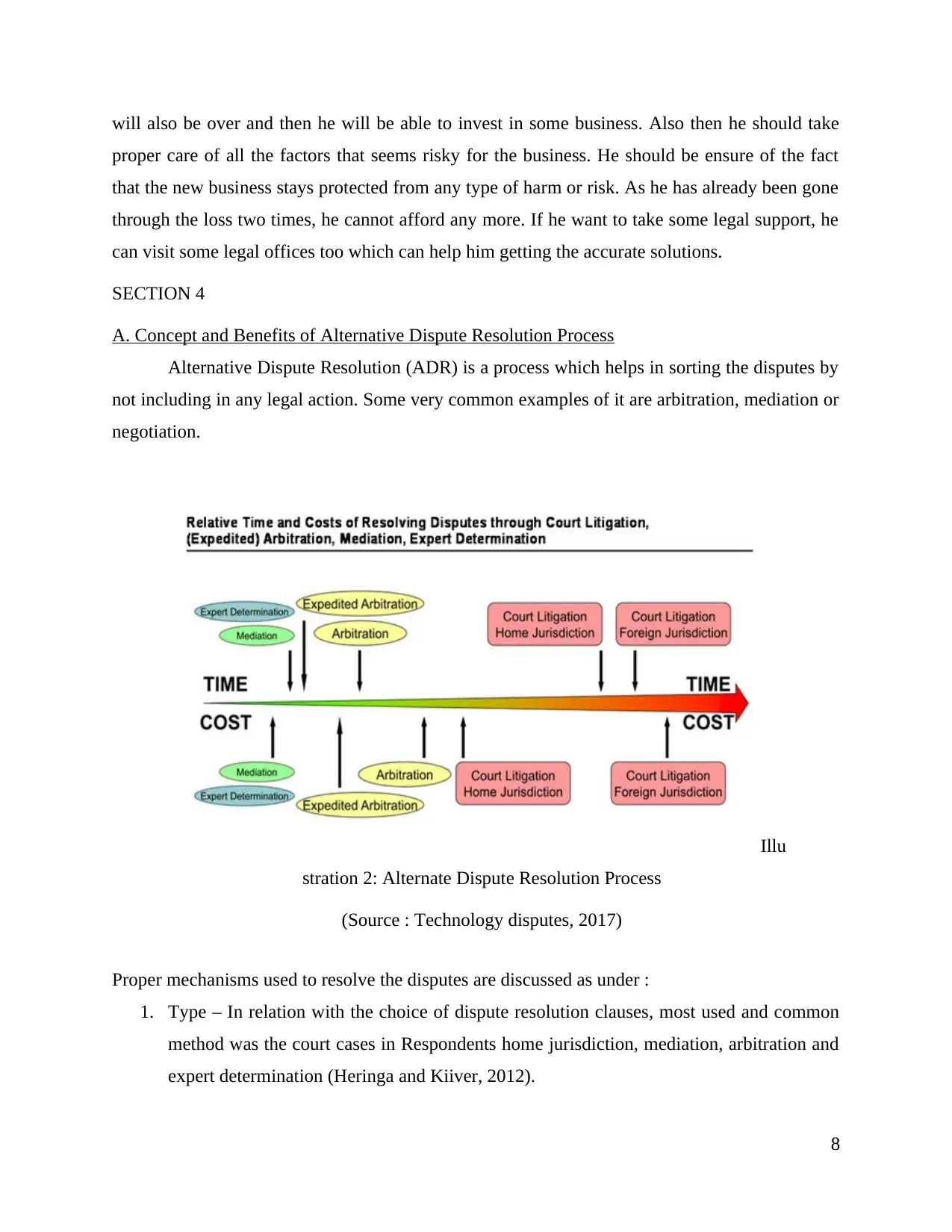
will also be over and then he will be able to invest in some business. Also then he should take
proper care of all the factors that seems risky for the business. He should be ensure of the fact
that the new business stays protected from any type of harm or risk. As he has already been gone
through the loss two times, he cannot afford any more. If he want to take some legal support, he
can visit some legal offices too which can help him getting the accurate solutions.
SECTION 4
A. Concept and Benefits of Alternative Dispute Resolution Process
Alternative Dispute Resolution (ADR) is a process which helps in sorting the disputes by
not including in any legal action. Some very common examples of it are arbitration, mediation or
negotiation.
Proper mechanisms used to resolve the disputes are discussed as under :
1. Type – In relation with the choice of dispute resolution clauses, most used and common
method was the court cases in Respondents home jurisdiction, mediation, arbitration and
expert determination (Heringa and Kiiver, 2012).
8
Illu
stration 2: Alternate Dispute Resolution Process
(Source : Technology disputes, 2017)
proper care of all the factors that seems risky for the business. He should be ensure of the fact
that the new business stays protected from any type of harm or risk. As he has already been gone
through the loss two times, he cannot afford any more. If he want to take some legal support, he
can visit some legal offices too which can help him getting the accurate solutions.
SECTION 4
A. Concept and Benefits of Alternative Dispute Resolution Process
Alternative Dispute Resolution (ADR) is a process which helps in sorting the disputes by
not including in any legal action. Some very common examples of it are arbitration, mediation or
negotiation.
Proper mechanisms used to resolve the disputes are discussed as under :
1. Type – In relation with the choice of dispute resolution clauses, most used and common
method was the court cases in Respondents home jurisdiction, mediation, arbitration and
expert determination (Heringa and Kiiver, 2012).
8
Illu
stration 2: Alternate Dispute Resolution Process
(Source : Technology disputes, 2017)
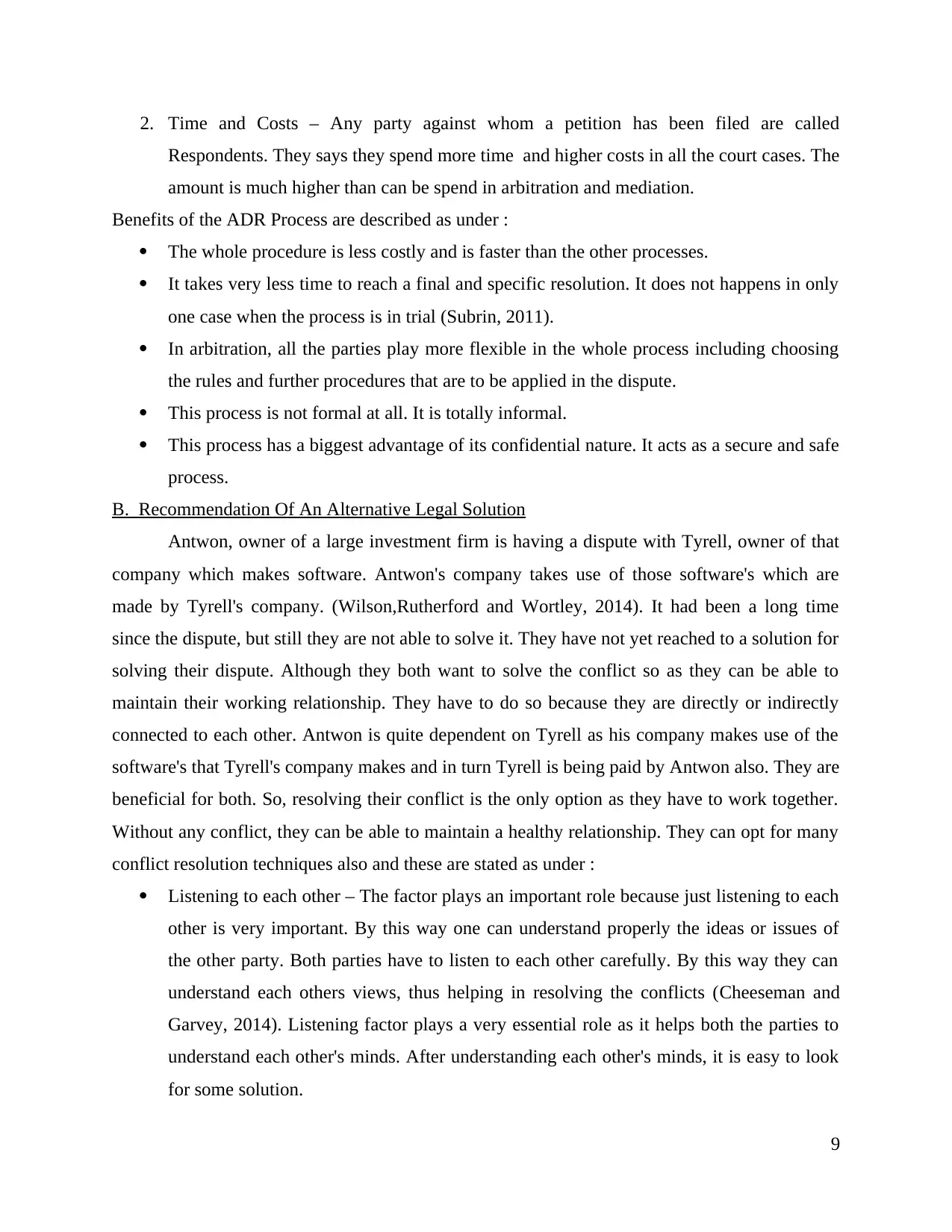
2. Time and Costs – Any party against whom a petition has been filed are called
Respondents. They says they spend more time and higher costs in all the court cases. The
amount is much higher than can be spend in arbitration and mediation.
Benefits of the ADR Process are described as under :
The whole procedure is less costly and is faster than the other processes.
It takes very less time to reach a final and specific resolution. It does not happens in only
one case when the process is in trial (Subrin, 2011).
In arbitration, all the parties play more flexible in the whole process including choosing
the rules and further procedures that are to be applied in the dispute.
This process is not formal at all. It is totally informal.
This process has a biggest advantage of its confidential nature. It acts as a secure and safe
process.
B. Recommendation Of An Alternative Legal Solution
Antwon, owner of a large investment firm is having a dispute with Tyrell, owner of that
company which makes software. Antwon's company takes use of those software's which are
made by Tyrell's company. (Wilson,Rutherford and Wortley, 2014). It had been a long time
since the dispute, but still they are not able to solve it. They have not yet reached to a solution for
solving their dispute. Although they both want to solve the conflict so as they can be able to
maintain their working relationship. They have to do so because they are directly or indirectly
connected to each other. Antwon is quite dependent on Tyrell as his company makes use of the
software's that Tyrell's company makes and in turn Tyrell is being paid by Antwon also. They are
beneficial for both. So, resolving their conflict is the only option as they have to work together.
Without any conflict, they can be able to maintain a healthy relationship. They can opt for many
conflict resolution techniques also and these are stated as under :
Listening to each other – The factor plays an important role because just listening to each
other is very important. By this way one can understand properly the ideas or issues of
the other party. Both parties have to listen to each other carefully. By this way they can
understand each others views, thus helping in resolving the conflicts (Cheeseman and
Garvey, 2014). Listening factor plays a very essential role as it helps both the parties to
understand each other's minds. After understanding each other's minds, it is easy to look
for some solution.
9
Respondents. They says they spend more time and higher costs in all the court cases. The
amount is much higher than can be spend in arbitration and mediation.
Benefits of the ADR Process are described as under :
The whole procedure is less costly and is faster than the other processes.
It takes very less time to reach a final and specific resolution. It does not happens in only
one case when the process is in trial (Subrin, 2011).
In arbitration, all the parties play more flexible in the whole process including choosing
the rules and further procedures that are to be applied in the dispute.
This process is not formal at all. It is totally informal.
This process has a biggest advantage of its confidential nature. It acts as a secure and safe
process.
B. Recommendation Of An Alternative Legal Solution
Antwon, owner of a large investment firm is having a dispute with Tyrell, owner of that
company which makes software. Antwon's company takes use of those software's which are
made by Tyrell's company. (Wilson,Rutherford and Wortley, 2014). It had been a long time
since the dispute, but still they are not able to solve it. They have not yet reached to a solution for
solving their dispute. Although they both want to solve the conflict so as they can be able to
maintain their working relationship. They have to do so because they are directly or indirectly
connected to each other. Antwon is quite dependent on Tyrell as his company makes use of the
software's that Tyrell's company makes and in turn Tyrell is being paid by Antwon also. They are
beneficial for both. So, resolving their conflict is the only option as they have to work together.
Without any conflict, they can be able to maintain a healthy relationship. They can opt for many
conflict resolution techniques also and these are stated as under :
Listening to each other – The factor plays an important role because just listening to each
other is very important. By this way one can understand properly the ideas or issues of
the other party. Both parties have to listen to each other carefully. By this way they can
understand each others views, thus helping in resolving the conflicts (Cheeseman and
Garvey, 2014). Listening factor plays a very essential role as it helps both the parties to
understand each other's minds. After understanding each other's minds, it is easy to look
for some solution.
9
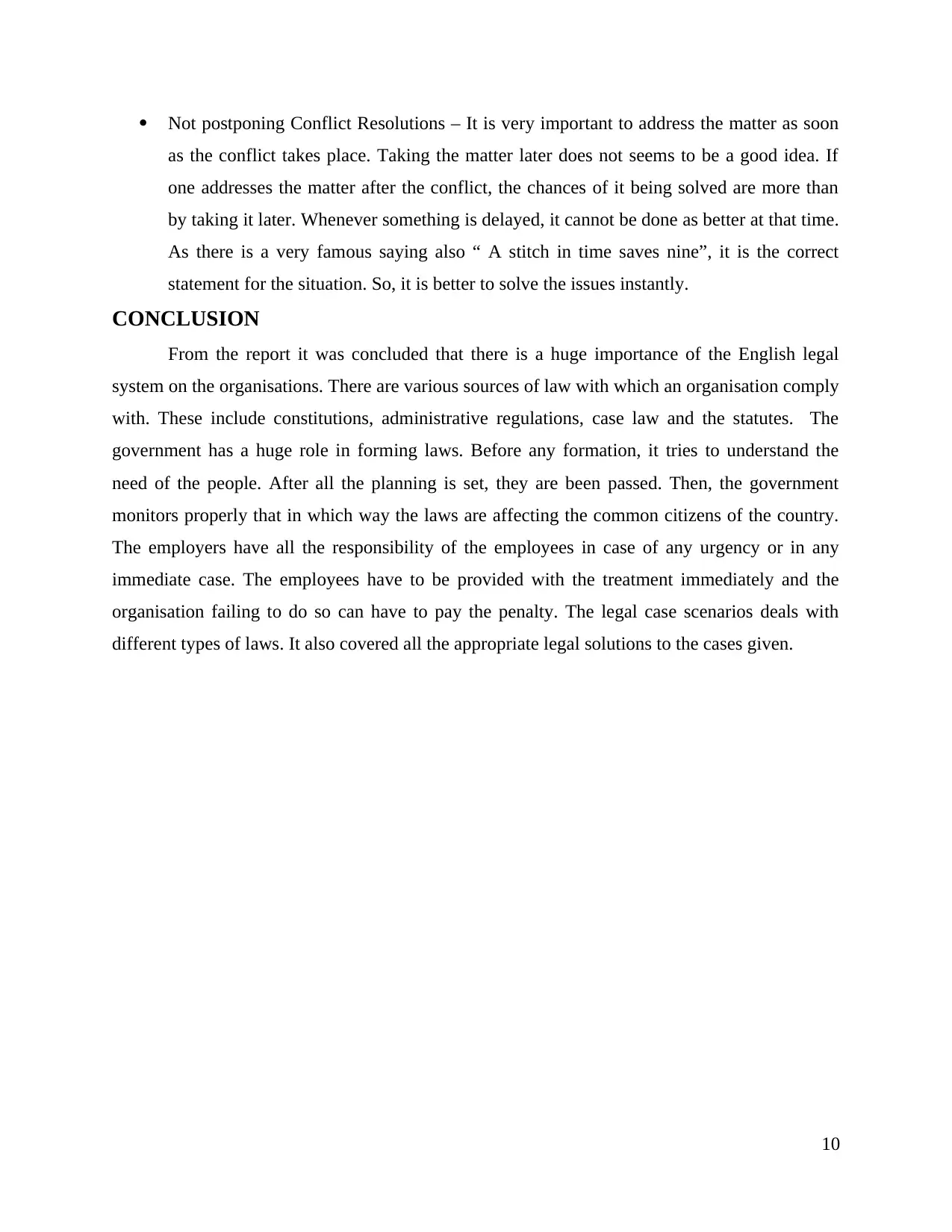
Not postponing Conflict Resolutions – It is very important to address the matter as soon
as the conflict takes place. Taking the matter later does not seems to be a good idea. If
one addresses the matter after the conflict, the chances of it being solved are more than
by taking it later. Whenever something is delayed, it cannot be done as better at that time.
As there is a very famous saying also “ A stitch in time saves nine”, it is the correct
statement for the situation. So, it is better to solve the issues instantly.
CONCLUSION
From the report it was concluded that there is a huge importance of the English legal
system on the organisations. There are various sources of law with which an organisation comply
with. These include constitutions, administrative regulations, case law and the statutes. The
government has a huge role in forming laws. Before any formation, it tries to understand the
need of the people. After all the planning is set, they are been passed. Then, the government
monitors properly that in which way the laws are affecting the common citizens of the country.
The employers have all the responsibility of the employees in case of any urgency or in any
immediate case. The employees have to be provided with the treatment immediately and the
organisation failing to do so can have to pay the penalty. The legal case scenarios deals with
different types of laws. It also covered all the appropriate legal solutions to the cases given.
10
as the conflict takes place. Taking the matter later does not seems to be a good idea. If
one addresses the matter after the conflict, the chances of it being solved are more than
by taking it later. Whenever something is delayed, it cannot be done as better at that time.
As there is a very famous saying also “ A stitch in time saves nine”, it is the correct
statement for the situation. So, it is better to solve the issues instantly.
CONCLUSION
From the report it was concluded that there is a huge importance of the English legal
system on the organisations. There are various sources of law with which an organisation comply
with. These include constitutions, administrative regulations, case law and the statutes. The
government has a huge role in forming laws. Before any formation, it tries to understand the
need of the people. After all the planning is set, they are been passed. Then, the government
monitors properly that in which way the laws are affecting the common citizens of the country.
The employers have all the responsibility of the employees in case of any urgency or in any
immediate case. The employees have to be provided with the treatment immediately and the
organisation failing to do so can have to pay the penalty. The legal case scenarios deals with
different types of laws. It also covered all the appropriate legal solutions to the cases given.
10
Paraphrase This Document
Need a fresh take? Get an instant paraphrase of this document with our AI Paraphraser
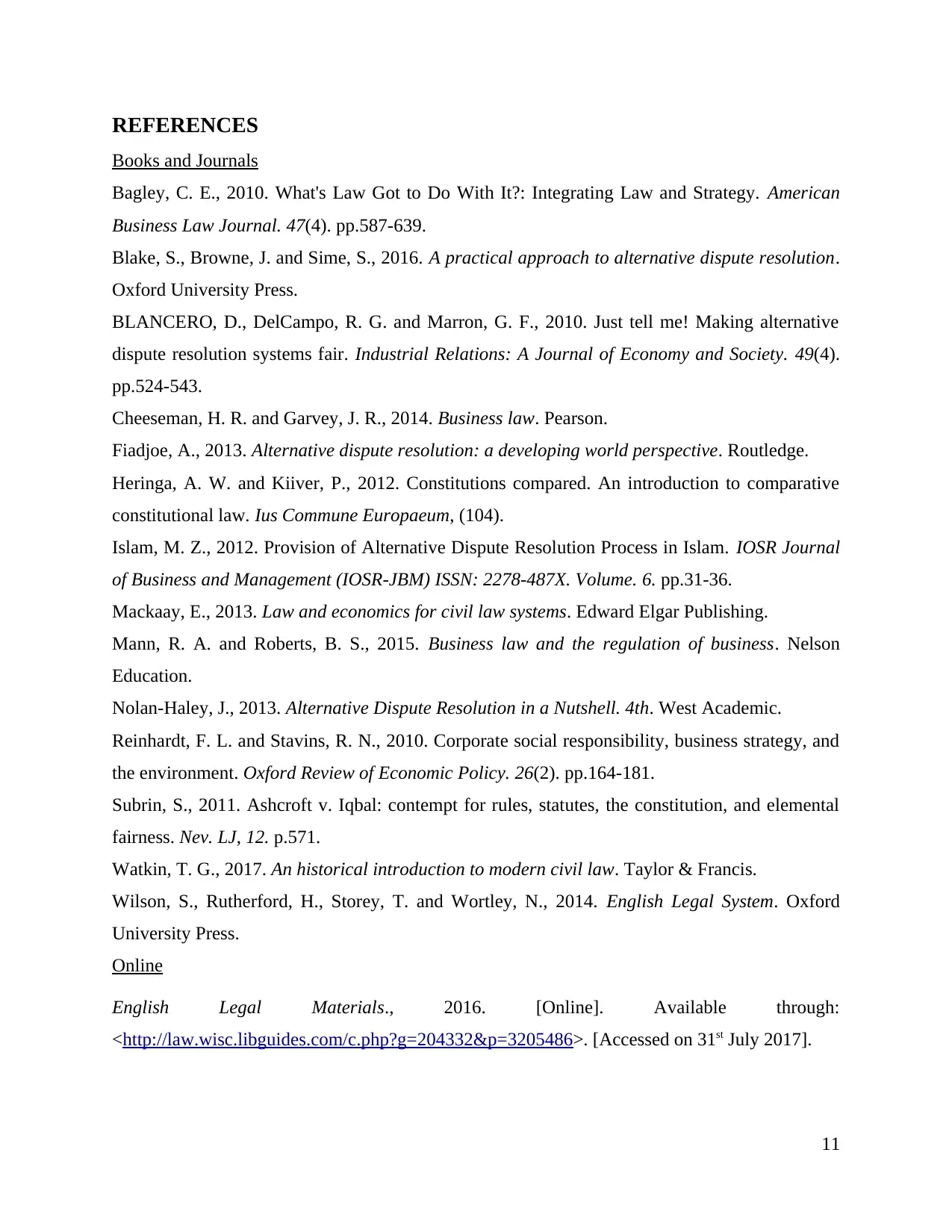
REFERENCES
Books and Journals
Bagley, C. E., 2010. What's Law Got to Do With It?: Integrating Law and Strategy. American
Business Law Journal. 47(4). pp.587-639.
Blake, S., Browne, J. and Sime, S., 2016. A practical approach to alternative dispute resolution.
Oxford University Press.
BLANCERO, D., DelCampo, R. G. and Marron, G. F., 2010. Just tell me! Making alternative
dispute resolution systems fair. Industrial Relations: A Journal of Economy and Society. 49(4).
pp.524-543.
Cheeseman, H. R. and Garvey, J. R., 2014. Business law. Pearson.
Fiadjoe, A., 2013. Alternative dispute resolution: a developing world perspective. Routledge.
Heringa, A. W. and Kiiver, P., 2012. Constitutions compared. An introduction to comparative
constitutional law. Ius Commune Europaeum, (104).
Islam, M. Z., 2012. Provision of Alternative Dispute Resolution Process in Islam. IOSR Journal
of Business and Management (IOSR-JBM) ISSN: 2278-487X. Volume. 6. pp.31-36.
Mackaay, E., 2013. Law and economics for civil law systems. Edward Elgar Publishing.
Mann, R. A. and Roberts, B. S., 2015. Business law and the regulation of business. Nelson
Education.
Nolan-Haley, J., 2013. Alternative Dispute Resolution in a Nutshell. 4th. West Academic.
Reinhardt, F. L. and Stavins, R. N., 2010. Corporate social responsibility, business strategy, and
the environment. Oxford Review of Economic Policy. 26(2). pp.164-181.
Subrin, S., 2011. Ashcroft v. Iqbal: contempt for rules, statutes, the constitution, and elemental
fairness. Nev. LJ, 12. p.571.
Watkin, T. G., 2017. An historical introduction to modern civil law. Taylor & Francis.
Wilson, S., Rutherford, H., Storey, T. and Wortley, N., 2014. English Legal System. Oxford
University Press.
Online
English Legal Materials., 2016. [Online]. Available through:
<http://law.wisc.libguides.com/c.php?g=204332&p=3205486>. [Accessed on 31st July 2017].
11
Books and Journals
Bagley, C. E., 2010. What's Law Got to Do With It?: Integrating Law and Strategy. American
Business Law Journal. 47(4). pp.587-639.
Blake, S., Browne, J. and Sime, S., 2016. A practical approach to alternative dispute resolution.
Oxford University Press.
BLANCERO, D., DelCampo, R. G. and Marron, G. F., 2010. Just tell me! Making alternative
dispute resolution systems fair. Industrial Relations: A Journal of Economy and Society. 49(4).
pp.524-543.
Cheeseman, H. R. and Garvey, J. R., 2014. Business law. Pearson.
Fiadjoe, A., 2013. Alternative dispute resolution: a developing world perspective. Routledge.
Heringa, A. W. and Kiiver, P., 2012. Constitutions compared. An introduction to comparative
constitutional law. Ius Commune Europaeum, (104).
Islam, M. Z., 2012. Provision of Alternative Dispute Resolution Process in Islam. IOSR Journal
of Business and Management (IOSR-JBM) ISSN: 2278-487X. Volume. 6. pp.31-36.
Mackaay, E., 2013. Law and economics for civil law systems. Edward Elgar Publishing.
Mann, R. A. and Roberts, B. S., 2015. Business law and the regulation of business. Nelson
Education.
Nolan-Haley, J., 2013. Alternative Dispute Resolution in a Nutshell. 4th. West Academic.
Reinhardt, F. L. and Stavins, R. N., 2010. Corporate social responsibility, business strategy, and
the environment. Oxford Review of Economic Policy. 26(2). pp.164-181.
Subrin, S., 2011. Ashcroft v. Iqbal: contempt for rules, statutes, the constitution, and elemental
fairness. Nev. LJ, 12. p.571.
Watkin, T. G., 2017. An historical introduction to modern civil law. Taylor & Francis.
Wilson, S., Rutherford, H., Storey, T. and Wortley, N., 2014. English Legal System. Oxford
University Press.
Online
English Legal Materials., 2016. [Online]. Available through:
<http://law.wisc.libguides.com/c.php?g=204332&p=3205486>. [Accessed on 31st July 2017].
11
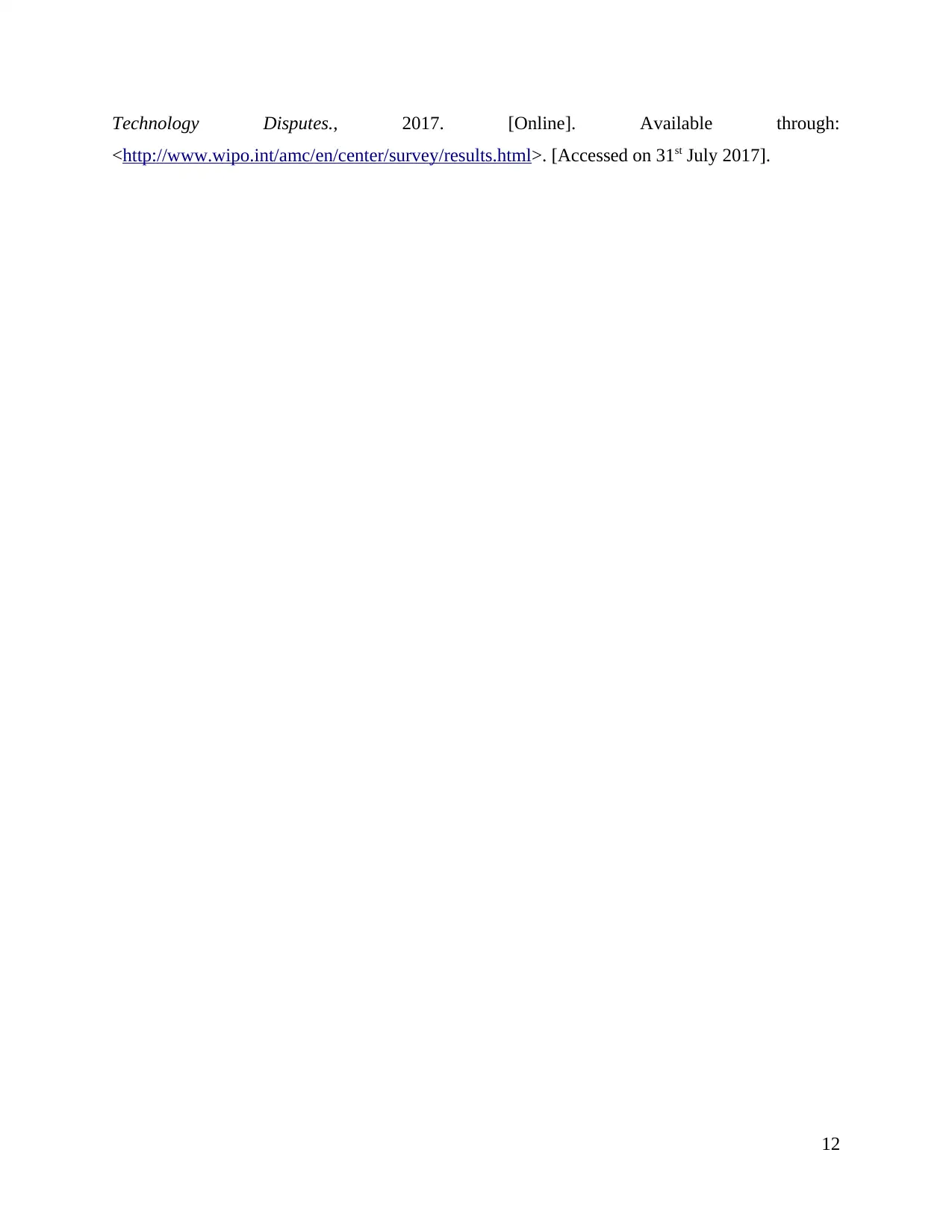
Technology Disputes., 2017. [Online]. Available through:
<http://www.wipo.int/amc/en/center/survey/results.html>. [Accessed on 31st July 2017].
12
<http://www.wipo.int/amc/en/center/survey/results.html>. [Accessed on 31st July 2017].
12
1 out of 15
Related Documents
Your All-in-One AI-Powered Toolkit for Academic Success.
+13062052269
info@desklib.com
Available 24*7 on WhatsApp / Email
![[object Object]](/_next/static/media/star-bottom.7253800d.svg)
Unlock your academic potential
© 2024 | Zucol Services PVT LTD | All rights reserved.





